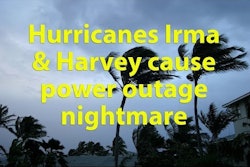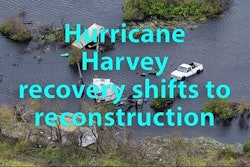Construction News Tracker is a presentation of Caterpillar and produced by ForConstructionPros.com.
With the focus now on Puerto Rico and the U.S. territories following major hurricanes recovery and rebuilding efforts are beginning. The U.S. Department of Transportation has released $40 million in immediate aid to Puerto Rico to repair roads and bridges destroyed or damaged by Hurricane Maria, and FEMA has tabbed the U.S Army Corps of Engineers to rebuild the island's infrastructure.
Could there be price gouging related to hurricane debris cleanup? Some affected municipalities are alleging that fact. Houston had contracts in place prior to Hurricane Harvey for payment of $7.69 per cubic yard for removal — an estimated 8 million cubic yards of debris remains to be collected — but was then forced to raise the rate to $11.69 to keep the cleanup crews in the area after Hurricane Irma struck Florida. Now, in much of the sunshine state debris removal crews are charging upwards of $20 per cubic yard for the same work. Lawmakers are unhappy as a result, and the attorney general is looking into the situation.
Florida has reportedly exhausted its supply of insurance adjusters. As the repair and rebuilding process gains steam, the state is having to reach out to other states to locate adjusters. According to the Wall Street Journal, there are 57,000 independent adjusters in the U.S., and many went to flood ravaged Texas to assess claims from Hurricane Harvey that came in advance of Irma.
The U.S. House of Representatives has passed legislation to modify the national flood insurance program. Congressmen say private companies ought to be permitted to write flood insurance policies, but the U.S. Senate is balking, even considering the residual effects of recent hurricanes. The NFIP presently faces a $90 billion cost overrun and expires in December. The hurricanes have even affected the nation's job numbers. Instead of adding an expected 75,000 jobs in September the U.S. actually lost 33,000 jobs the first decline in six years. The unemployment rate has fallen to 4.2% as a result.
OSHA will not begin enforcing its controversial silica rules until October 30th, another 30 days reprieve. Construction as a whole is fighting the revised dust rules for sites, and a court challenge is underway.
The new single family home market is reportedly taking a hit as a result of the recent hurricanes. The National Association of Home Builders Wells Fargo Housing Market Index has fallen from its mark of 67 in August to 64 in September. The rising cost of materials and lack of labor has hit the industry in the wake of the storms, and not expected to rebound until substantial home building repairs are addressed. Despite the posted losses in all categories in September, the HMI Index remains at healthy levels.
The latest from Dodge Data indicates the value of construction starts fell to a seasonally adjusted rate of $711.6 billion in August, a slight 2% drop from July. Institutional projects was the data leader with some major construction underway, leading the nonresidential category to a 14% gain. However, the non building sector fell 24%, and multifamily was off 1% for the month. The Dodge Index for August comes in at 151 indicating a potential rebound for construction starts in the second half of the year.
A new law set to take effect in January requires California contractors to pay the wages of subcontractor employees if the subs fail to do so. Passed by the legislature, it awaits Gov. Jerry Brown's signature. Under the measure, direct contractors would have to pay wages ,benefits and interest but not penalties in the event their subs reneged on employee payment. In addition, contractors would be entitled to their subs' payroll records to check information. The construction industry is warning the action will result in higher building costs in the state.
Indiana is opening up a $4.7 billion infrastructure program that will cover the next five years. Under the effort outlined by Gov. Eric Holcomb, the state is set to add 122 miles of new roads, spend $342 million on existing road improvements, rehabiltate 1,295 bridges and expand Interstate Highway 69 left abandoned after a failed P3 partnership. It’ll be paid for by a new 10 cent per gallon hike in the Indiana gasoline tax as well as new vehicle fee increases. The governor also wants to build a $6 million highway from the recently completed East End Crossing near Louisville, KY, to a planned port of Indiana industrial park.
Cricket anyone? It's one of the fastest growing sports in the world, and developers hope it will soon take on interest in the U.S. That's why Global Sports Ventures is partnering with JLL Sports and Entertainment to develop stadiums in the U.S. At least eight stadiums in cities showing interest in California, Florida, New York, New Jersey, Georgia, Illinois, Texas and Washington D.C. have been tabbed for professional teams. With an investment of $2.4 billion, the stadiums alone are expected to cost between $70 and $125 million each to be constructed by 2020.
Wrapping it up, time is like a handful of sand. The tighter you grasp it, the faster it runs through your fingers.
This is Construction News Tracker looking over the industry that makes the world a better place, presented by Caterpillar and produced by ForConstructionPros.com.
Follow us on social media at Twitter using #constructionnews,YouTube and Facebook as the streaming Web never ends.



















